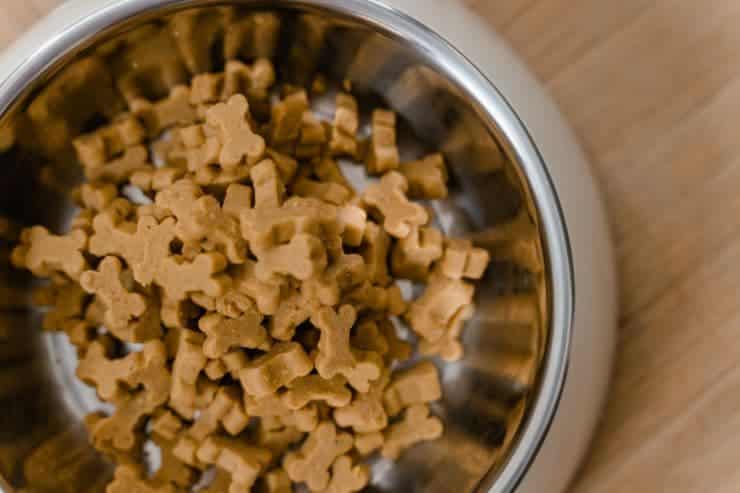The quest for quality nutrition is paramount in ensuring the longevity and overall well-being of our furry companions. With a market flooded with various brands and types of dog food, deciphering the nutritional code may seem like an uphill task for pet parents. A substantial part of the journey is understanding the ingredients listed on dog food labels.
The Pet Food Industry Association of Australia urges all dog owners to be especially careful when choosing commercial dog food taking into account any disorders as well as particular breed-specific food intolerances that may affect your dog.
![]()

Photo Credit: MART PRODUCTION/Pexels
A balanced diet is as crucial for our furry companions as it is for us. The market is awash with a variety of commercial dog food options, particularly kibble, each claiming to offer a wholesome diet for your dog. Unravelling the composition of these commercial dog foods can provide a clearer insight into the nutritional value they offer.
Source: Proteins are indispensable for a dog's growth, muscle development, and overall tissue repair. The primary sources of protein in commercial dog food include chicken, beef, lamb, fish, and sometimes plant-based proteins like soy.
Quality Indicator: High-quality dog food brands often list whole meats as the first ingredient, signifying a high protein content. The specificity of the protein source (e.g., deboned chicken, beef liver) is a good quality indicator.
Source: Carbohydrates are energy-providing nutrients. Common sources include grains such as rice, barley, and oats, as well as vegetables like sweet potatoes.
Digestibility: The digestibility of carbohydrates is crucial. Whole grains and specified carbohydrate sources are generally more digestible and nutritionally superior to vague descriptions like "cereal by-products."
Source: Fats are necessary for energy, skin and coat health, and absorption of fat-soluble vitamins. They typically come from specified animal fats, fish oil, and vegetable oils.
Omega Fatty Acids: The presence of Omega-3 and Omega-6 fatty acids is desirable for promoting a shiny coat and supporting immune system function.
Photo Credit: mattycoulton/Pixabay
Source: Essential for a multitude of bodily functions, vitamins and minerals are usually added as supplements, though they also naturally occur in some ingredients.
Balance: A balanced blend of vitamins and minerals supports bone health, immune function, and overall physiological well-being.
Fillers: Fillers like corn and wheat by-products add bulk to the food but offer little to no nutritional value. They are often used in lower-quality dog foods to reduce production costs.
Preservatives: While preservatives are necessary to extend the shelf life of kibble, natural alternatives like mixed tocopherols are safer than artificial preservatives like BHA and BHT.
Functional Additives: Some dog foods contain functional additives like probiotics for digestive health or glucosamine for joint support.
Flavour Enhancers: Flavour enhancers and artificial colours may be used to make the food more appealing, but they offer no nutritional benefit.
The composition of commercial dog food is a medley of essential nutrients mixed with certain ingredients that may not contribute to the overall health of your dog. Such breeds as Shar Pei, for example, are prone to severe allergies because of some ingredients found in commercial food. That's why Golden Retriever breeders in Australia consider it necessary to be aware of the common ingredients and understand the implications of each so they can make informed choices for their dog's nutrition.
This knowledge is the cornerstone for selecting high-quality dog food that caters to the unique dietary needs of your canine companion.
Photo Credit: mattycoulton/Pixabay
Low-quality ingredients not only fail to provide the essential nutrients but can also pose health risks to your furry friend. Here are some of the hallmark ingredients of lower-quality dog food.
Definition: Meat by-products are what remain after the prime cuts have been taken for human consumption. This includes organs and other parts which, while not inherently harmful, are of lower nutritional value compared to whole meats.
Concerns: By-products can come from unspecified sources, making it hard to determine their quality or if they are suitable for dogs with specific dietary sensitivities.
Common Types: BHA, BHT, and ethoxyquin are artificial preservatives, while artificial colours include Red 40, Yellow 5, and Blue 2.
Health Implications: Artificial preservatives have been linked to potential carcinogenic effects, and artificial colours can cause allergic reactions and behavioural issues in some dogs.
Usage: These are used as cheap fillers to bulk up the dog food.
Digestibility: Corn and wheat gluten are less digestible and can cause allergic reactions in some dogs, leading to skin, coat, and digestive issues.
Indication: When the fat source is generically listed as “animal fat,” it’s a red flag because it doesn’t specify the source, making the quality questionable.
Quality Dog Food Indicator: High-quality dog foods will specify the source of fat, such as “chicken fat” or “salmon oil.”
Potential Harm: Sugars and sweeteners like corn syrup can lead to obesity, dental issues, and even diabetes.
Purpose: They are often added to make the food more palatable, but have no nutritional benefit.
Usage: This is used to maintain moisture in certain types of dog food.
Health Concerns: It can be toxic in large quantities and is not a necessary ingredient for dog food.
Definition: Cellulose, derived from plant fibres, is an indigestible filler used to add bulk to dog food.
Nutritional Value: It provides no nutritional value and can contribute to a feeling of fullness without meeting your dog’s nutritional needs.
Discerning the quality of dog food largely hinges on understanding the implications of various ingredients listed on the label. Steering clear from dog food laden with artificial additives, unspecified meat sources, and unnecessary fillers is a significant stride towards promoting the holistic health and longevity of your beloved pet.
By being informed and making mindful selections, you contribute to a happier, healthier life for your dog.
You may also like:
We use cookies to offer you a better browsing experience, analyze site traffic, personalize content and ads.